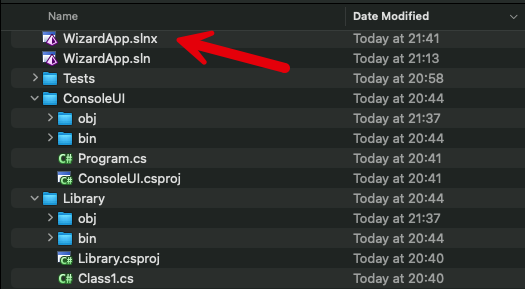SLNX - New .NET Solution File Format
[.NET, Visual Studio]
In the last post, we looked at how to manage multi-project software using solutions.
As a recap, the solution file looked like this:
Microsoft Visual Studio Solution File, Format Version 12.00
# Visual Studio Version 17
VisualStudioVersion = 17.0.31903.59
MinimumVisualStudioVersion = 10.0.40219.1
Project("{FAE04EC0-301F-11D3-BF4B-00C04F79EFBC}") = "Library", "Library\Library.csproj", "{377BD026-7E71-47B4-BFFC-A5BA74C012EA}"
EndProject
Project("{FAE04EC0-301F-11D3-BF4B-00C04F79EFBC}") = "ConsoleUI", "ConsoleUI\ConsoleUI.csproj", "{F664F180-4385-4ABA-935C-DF24FA652B30}"
EndProject
Global
GlobalSection(SolutionConfigurationPlatforms) = preSolution
Debug|Any CPU = Debug|Any CPU
Debug|x64 = Debug|x64
Debug|x86 = Debug|x86
Release|Any CPU = Release|Any CPU
Release|x64 = Release|x64
Release|x86 = Release|x86
EndGlobalSection
GlobalSection(ProjectConfigurationPlatforms) = postSolution
{377BD026-7E71-47B4-BFFC-A5BA74C012EA}.Debug|Any CPU.ActiveCfg = Debug|Any CPU
{377BD026-7E71-47B4-BFFC-A5BA74C012EA}.Debug|Any CPU.Build.0 = Debug|Any CPU
{377BD026-7E71-47B4-BFFC-A5BA74C012EA}.Debug|x64.ActiveCfg = Debug|Any CPU
{377BD026-7E71-47B4-BFFC-A5BA74C012EA}.Debug|x64.Build.0 = Debug|Any CPU
{377BD026-7E71-47B4-BFFC-A5BA74C012EA}.Debug|x86.ActiveCfg = Debug|Any CPU
{377BD026-7E71-47B4-BFFC-A5BA74C012EA}.Debug|x86.Build.0 = Debug|Any CPU
{377BD026-7E71-47B4-BFFC-A5BA74C012EA}.Release|Any CPU.ActiveCfg = Release|Any CPU
{377BD026-7E71-47B4-BFFC-A5BA74C012EA}.Release|Any CPU.Build.0 = Release|Any CPU
{377BD026-7E71-47B4-BFFC-A5BA74C012EA}.Release|x64.ActiveCfg = Release|Any CPU
{377BD026-7E71-47B4-BFFC-A5BA74C012EA}.Release|x64.Build.0 = Release|Any CPU
{377BD026-7E71-47B4-BFFC-A5BA74C012EA}.Release|x86.ActiveCfg = Release|Any CPU
{377BD026-7E71-47B4-BFFC-A5BA74C012EA}.Release|x86.Build.0 = Release|Any CPU
{F664F180-4385-4ABA-935C-DF24FA652B30}.Debug|Any CPU.ActiveCfg = Debug|Any CPU
{F664F180-4385-4ABA-935C-DF24FA652B30}.Debug|Any CPU.Build.0 = Debug|Any CPU
{F664F180-4385-4ABA-935C-DF24FA652B30}.Debug|x64.ActiveCfg = Debug|Any CPU
{F664F180-4385-4ABA-935C-DF24FA652B30}.Debug|x64.Build.0 = Debug|Any CPU
{F664F180-4385-4ABA-935C-DF24FA652B30}.Debug|x86.ActiveCfg = Debug|Any CPU
{F664F180-4385-4ABA-935C-DF24FA652B30}.Debug|x86.Build.0 = Debug|Any CPU
{F664F180-4385-4ABA-935C-DF24FA652B30}.Release|Any CPU.ActiveCfg = Release|Any CPU
{F664F180-4385-4ABA-935C-DF24FA652B30}.Release|Any CPU.Build.0 = Release|Any CPU
{F664F180-4385-4ABA-935C-DF24FA652B30}.Release|x64.ActiveCfg = Release|Any CPU
{F664F180-4385-4ABA-935C-DF24FA652B30}.Release|x64.Build.0 = Release|Any CPU
{F664F180-4385-4ABA-935C-DF24FA652B30}.Release|x86.ActiveCfg = Release|Any CPU
{F664F180-4385-4ABA-935C-DF24FA652B30}.Release|x86.Build.0 = Release|Any CPU
EndGlobalSection
GlobalSection(SolutionProperties) = preSolution
HideSolutionNode = FALSE
EndGlobalSection
EndGlobal
This format has several challenges:
- It is very verbose
- It is difficult to track and merge via source control tools
- It has a lot of redundancy
- It is not very human-readable
Version 9.0.200 of the SDK onwards supports a new, XML-based solution format.
You can verify what SDK version is active using the following command:
dotnet --info
On my machine, I get the following:
.NET SDK:
Version: 9.0.202
Commit: 3a53853c30
Workload version: 9.0.200-manifests.2f9aa857
MSBuild version: 17.13.13+1c2026462
Runtime Environment:
OS Name: Mac OS X
OS Version: 14.7
OS Platform: Darwin
RID: osx-arm64
Base Path: /usr/local/share/dotnet/sdk/9.0.202/
.NET workloads installed:
There are no installed workloads to display.
Configured to use loose manifests when installing new manifests.
Host:
Version: 10.0.0-preview.1.25080.5
Architecture: arm64
Commit: b98cabca12
.NET SDKs installed:
9.0.202 [/usr/local/share/dotnet/sdk]
10.0.100-preview.1.25120.13 [/usr/local/share/dotnet/sdk]
.NET runtimes installed:
Microsoft.AspNetCore.App 9.0.3 [/usr/local/share/dotnet/shared/Microsoft.AspNetCore.App]
Microsoft.AspNetCore.App 10.0.0-preview.1.25120.3 [/usr/local/share/dotnet/shared/Microsoft.AspNetCore.App]
Microsoft.NETCore.App 9.0.3 [/usr/local/share/dotnet/shared/Microsoft.NETCore.App]
Microsoft.NETCore.App 10.0.0-preview.1.25080.5 [/usr/local/share/dotnet/shared/Microsoft.NETCore.App]
Other architectures found:
None
Environment variables:
Not set
global.json file:
/Users/rad/Projects/global.json
Learn more:
https://aka.ms/dotnet/info
Download .NET:
https://aka.ms/dotnet/download
To migrate to the new solution, run the command dotnet sln migrate from the directory your solution is in:
dotnet sln migrate
You will see a new file has been created with a .slnx extension - the original sln file is not deleted.

We can take a look at what is inside
cat WizardApp.slnx
<Solution>
<Configurations>
<Platform Name="Any CPU" />
<Platform Name="x64" />
<Platform Name="x86" />
</Configurations>
<Project Path="ConsoleUI/ConsoleUI.csproj" />
<Project Path="Library/Library.csproj" />
</Solution>
This is now vastly cleaner and simpler.
The dotnet sln commands will still work with this new format.
We can add back the xUnit test project
dotnet sln WizardApp.slnx add Tests/Tests.csproj
This will print the following:
Project `Tests/Tests.csproj` added to the solution.
If we now view the contents:
<Solution>
<Configurations>
<Platform Name="Any CPU" />
<Platform Name="x64" />
<Platform Name="x86" />
</Configurations>
<Project Path="ConsoleUI/ConsoleUI.csproj" />
<Project Path="Library/Library.csproj" />
<Project Path="Tests/Tests.csproj" />
</Solution>
TLDR
The new .slnx format is cleaner, simpler, and machine-readable, and being XML lends itself well to manipulation by tools.
The code is in my GitHub.
Happy hacking!